The journey of starting a saltwater aquarium may seem daunting, especially for those accustomed to freshwater setups. However, when I began marine fishkeeping, I discovered that with adequate research and preparation, the challenge becomes manageable. In this comprehensive guide, I’ve curated a selection of eleven saltwater aquarium fish specifically tailored for beginners, each possessing qualities that facilitate a smooth transition into the captivating realm of marine aquariums.

With that being said, to make things easier for the intimidated people, I researched a list of some of the saltwater aquarium fish that are great for beginners.
As my criteria, I cherry-picked colorful pet fish that should make your new tank look pretty exotic.
But it’s not just about the looks. To boost your confidence in this endeavor, I made sure to include peaceful and hardy marine fish species that are easier to keep.
We also need to consider the species’ full-grown size, as many novices start with small tanks.
So let me inspire you with the best beginner-friendly stocking ideas for a smaller 10 to 30-gallon saltwater aquarium.
11 Saltwater Aquarium Fish for True Novices
Since you’re a beginner, your new saltwater fish should be non-aggressive and robust in nature.
Also, you should opt for species that will feel comfortable with your fish tank’s size. This means that you should have an idea of how much water volume your new tank can hold from the start.
Even though all of the fish I’m about to list below are novice-friendly, you need to also be aware of their key traits and fundamental requirements. I made sure to mention those so that you keep your new pet healthy and happy.
Don’t be solely driven by the exotic looks and vibrant colors of these fish.
Pay attention to their behavioral characteristics, and their suitability for a community or a reef aquarium.
Some species are schooling, others like to spend their time alone.
Some would destroy corals, and others would be completely safe for a reef tank. Some would get along with virtually any tank mate, and others would be a bit picky about who they like.
With that being said, take a look at the best saltwater aquarium fish for beginners:
1. Possum Wrasse – Wetmorella nigropinnata
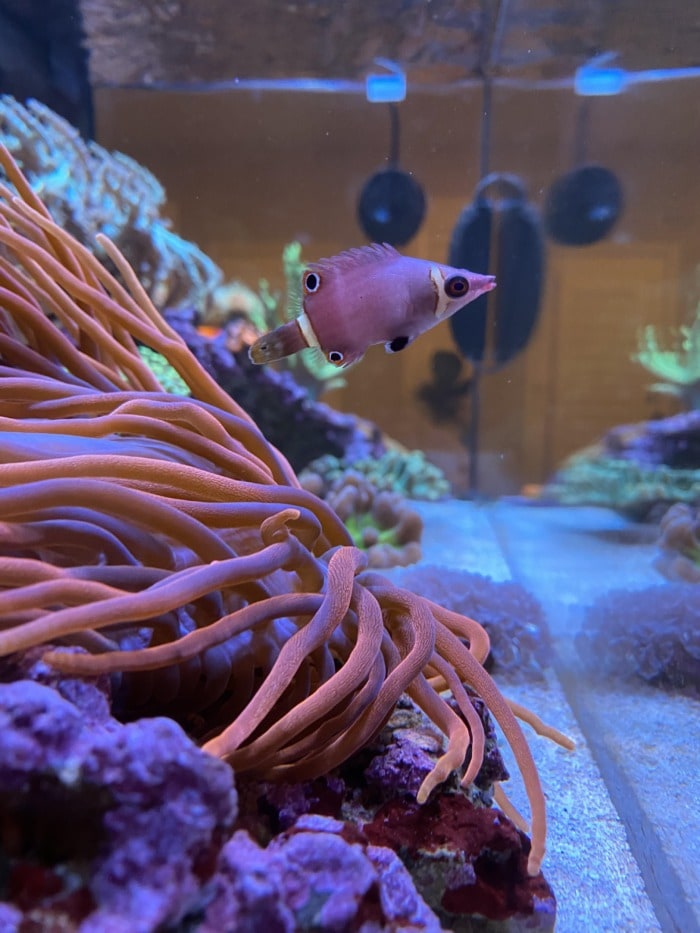
Coming from the Wetmorella genus, the small Possum Wrasse has a peaceful demeanor and a maximum size of around 3 inches. These traits make it one of the best saltwater fish for beginners who are still learning the specifics of the hobby.
Since this magical fish is hardy, it is easy to take care of and can be kept in a small 15-gallon tank.
With that being said, it can live a long and happy life in an even smaller 10-gallon nano tank.
I would always go for the bigger tank if I had the option to choose.
Just make sure you provide an environment that meets its modest needs.
The Possum Wrasse won’t hurt its tank mates, so it makes a great addition to a marine aquarium with other peaceful community fish.
Furthermore, it doesn’t nip at corals, so if you are to start a reef tank, this pygmy wrasse may be a perfect choice.

Anyway, these fish stand out with their beautiful red color and white vertical stripes.
If you’re looking to have a saltwater pet fish with an even more exotic look, you can research the Yellow Banded Possum Wrasses that have yellow vertical stripes instead of white ones.
Just keep in mind that the yellow-banded variety would be a bit more expensive.
Since they’re timid and want to have peace in their lives, Possum Wrasses need caves and rocks for hiding when they feel intimidated. Also, these fish are jumpers, so make sure the aquarium is sealed with a lid to prevent an accident.
The Possum wrasses are carnivores and are somewhat picky when it comes to food. I’ve found success when feeding them with frozen Mysis or brine shrimp and bloodworms.
Anyhow, when initially introduced to its new aquarium, a Possum wrasse would be a bit too shy.
Give it time to get used to its new environment and it will eventually start to roam around and show off its cool stripes more often.
To make it feel more comfortable, you can introduce two Possum Wrasses at the same time – just make sure one is male, and the other one – a female.
Getting a group of females and a male is also a safe option (this is called a “harem”).

When it comes to suitable tank mates – just make sure you stay away from the more aggressive saltwater fish.
Aggressive ones will take advantage of the peaceful nature of the Possum Wrasse and they will eventually be subjected to bullying.
With all being said, if you’re looking for a non-aggressive pet fish for your new saltwater aquarium, you should consider getting a Possum Wrasse.
However, if you’re looking for a more active and outgoing beginner-friendly fish, have a look at some of my next suggestions.
- Maximum adult size: 2.9 inches (7.4 cm);
- Minimum tank size: 10 gallons;
- Key traits: looks pretty exotic, hardy, timid, reef-safe, needs rockwork to hide and a lid to prevent it from jumping out of the tank; avoid aggressive tank mates, as Possum Wrasses may get bullied.
2. Ocellaris Clownfish – Amphiprion ocellaris

The Ocellaris Clownfish was well-known in the saltwater aquarium hobby even before the movie “Finding Nemo” aired.
There are many reasons why clownfish like this one from the Amphiprion genus are so popular among beginners.
The Ocellaris Clownfish is relatively peaceful, gets along with a vast majority of non-aggressive species, and is compatible with a reef tank. Furthermore, its bright orange colors and cool personality will make your saltwater aquarium an exciting display.
There are actually different types of clownfish that you can find in the aquarium trade.
The Ocellaris Clownfish is from the Damselfish family – Pomacentridae – and it’s also known as Common Clownfish or False Percula Clownfish.
Other clownfish representatives, such as the Maroon Clownfish, are more aggressive and are therefore best avoided if you’re new to the hobby. To avoid conflict among tank mates, I recommend getting an Ocellaris Clownfish for your new saltwater tank.
Furthermore – make sure yours is captive-bred, as this would make it even easier for you to look after it.
This is so because wild-caught clownfish aren’t accustomed to the home aquarium conditions.
You may experience some difficulties with feeding wild-caught clownfish and they may not get used to their new environment at all.
Captive-bred ones, on the other hand, are known for their hardiness and carefree acclimation.
Recommended read: How Long Do Clownfish Live in Captivity and in the Wild?
The Clownfish is perfect for smaller aquariums, as it only reaches around 3.5 inches when fully grown. Ideally, you should keep it in a 20-gallon tank as a minimum.
The tank mates of the Ocellaris Clownfish should not be aggressive.
Royal Grammas, Possum Wrasses, Tailspot Blennies, and Banggai Cardinals can be kept in a community tank with an Ocellaris without a problem.
Recommended to read next: Saltwater Fish Ideas for a 20-Gallon Aquarium
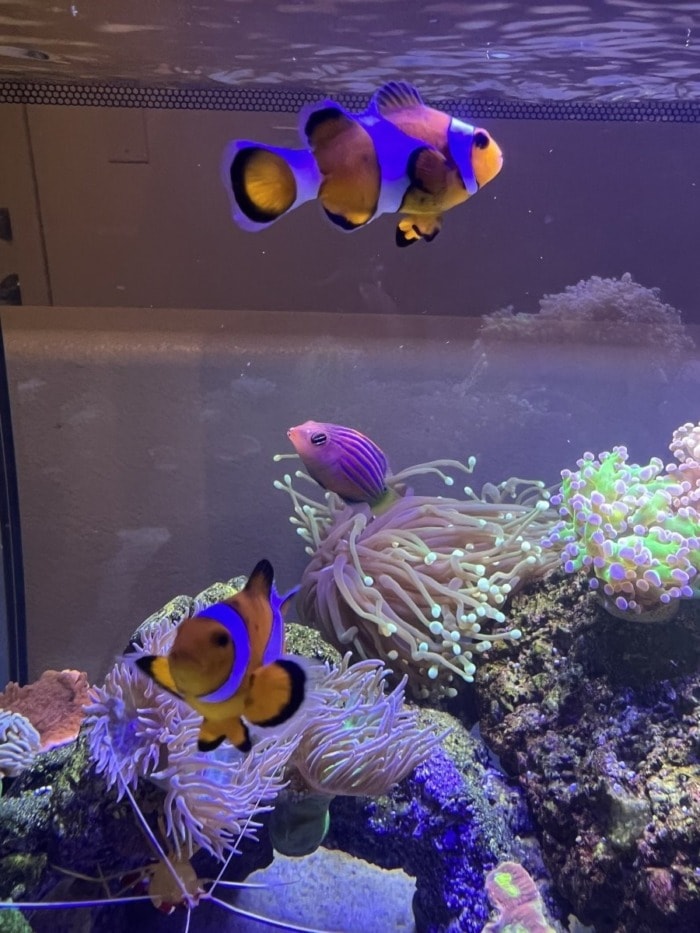
With that being said, you should be cautious when dealing with more than one Clownfish.
If you have a larger tank and you’re certain that you want to get a pair – add them to the tank simultaneously while they’re still juvenile.
Introducing an additional Ocellaris later would often lead to aggression.
With all being said, the Ocellaris Clownfish is a perfect choice for any aquarist who wants to start a classic saltwater setup.
Consider it as an option if you’re looking for colorful and resilient marine species for your new “Finding Nemo”-thematic aquarium.
- Max adult size: 3.5 inches (9 cm);
- Minimum tank size: 20-gallon aquarium;
- Key traits: colorful, peaceful, and hardy; community tank and reef-suitable.
3. Tailspot Blenny – Ecsenius stigmatura

The Tailspot Blenny is a small saltwater fish from a genus known as Ecsenius, that can live in a 10-gallon tank.
Since it’s non-aggressive and resilient, it is undoubtedly one of the best choices for a beginner-friendly saltwater pet fish.
Furthermore – it’s a herbivore that eats algae in the tank, and as such it will help you prevent unwanted algae growth.
In my experience, the Tailspot is more effective in controlling algae compared to the Lawnmower Blenny. My experience with it is the reason why I’ve included this species in my article where I list the best algae eaters for saltwater tanks.
Anyway, Tailspot Blennies aren’t as brightly colored as some more popular saltwater aquarium species, but I love their unique looks.
This marine species remains small, around 2.5 inches when fully grown, and has big dramatic eyes above its tiny mouth. These features give this nano fish an amusing facial expression pretty much all of the time.
Anyhow, when not roaming around in search of food, your Tailspot Blenny would need a place to rest and hide.
Caves and live rocks to graze on are a must if you are to house this pet.
This blenny would often get in-between crevices and stick its head out to observe what is going on in the tank, which I find quite entertaining.
Author’s note: The Tailspot Blenny is also suitable for reef tanks, as it won’t nip at corals.
Since this pet fish is very peaceful, you should avoid aggressive tank mates that may stress it out.
Anyway, at first, the Tailspot Blenny may be a bit shy, but in time it will start to feel more comfortable exploring its new aquarium and making friends.
Don’t be fooled: Although the Tailspot Blenny seems small in size its lifestyle does not allow for it to live normally in any tank that holds less than 10-gallons of water. If you’re interested in micro fish that will feel comfortable in a small tank I recommend checking my article on stocking ideas for a 5-gallon aquarium.
- Max adult size: 2.5 inches (6.4 cm);
- Minimum tank size: 10 gallons;
- Key traits: not aggressive in nature, algae eater, with some rare exceptions it won’t nip at corals, a bit shy in the beginning; great community fish with a variety of suitable tank mates, just make sure they’re peaceful.
4. Royal Gramma Basslet – Gramma Loreto
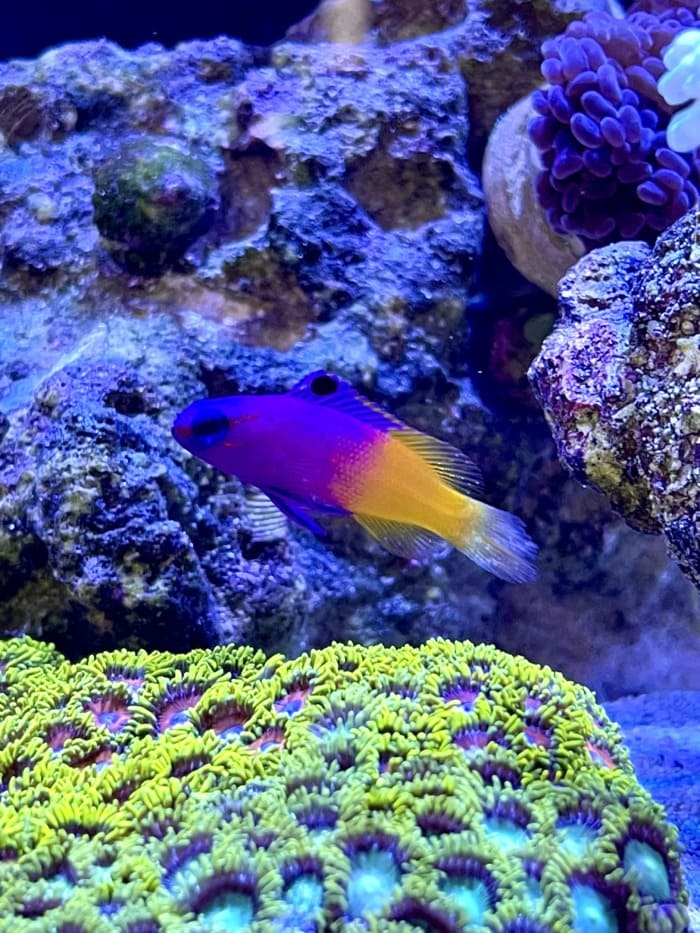
The Royal Gramma mainly inhabits reef environments in the tropical waters of the western Atlantic Ocean, namely the wider Caribbean.
The Royal Gramma Basslet is a very popular fish among beginners in the saltwater aquarium hobby. Moreover, I’d say it’s one of the most popular Gramma species for home fish tanks overall.
It’s non-aggressive towards other tank mates and it’s easy to take care of, but these are not the reasons it’s so famous among aquarists:
The Royal Gramma has a vibrant purple and yellow-colored body that helps it to exceptionally stand out in any aquarium.
It’s a rare combination of colors even by saltwater aquarium standards.

Anyway, even though this fish won’t harm other species, it’s best to keep no more than one Royal Gramma Basslet in the same aquarium.
This species can get quite aggressive towards its own kind so I recommend keeping it solo as a solution.
You should also avoid keeping it along with the Royal Dottyback also recognized as Pictichromis paccagnellae, as both fish are pretty similar in size and appearance and tend to fight among themselves.
With that being said, Royal Gramma Basslets won’t bother other peaceful tank mates.
These fish would typically try to hide from bright aquarium light. Unfortunately, bright lights are key to growing corals in your tank.
Therefore you need to add rockwork and caves to make your new Royal Gramma feel more comfortable.
It will use these hideouts more often at the beginning until it gets acclimated to the new environment.
The Royal Gramma would establish its home in one of the rock crevices and guard this spot when other marine inhabitants get nearby.
But don’t worry – these entitled pet fish would only scare intruders away, without hurting them.
Once the Royal Gramma gets used to its surroundings, it will start swimming around and show off its colors and entertaining personality more.
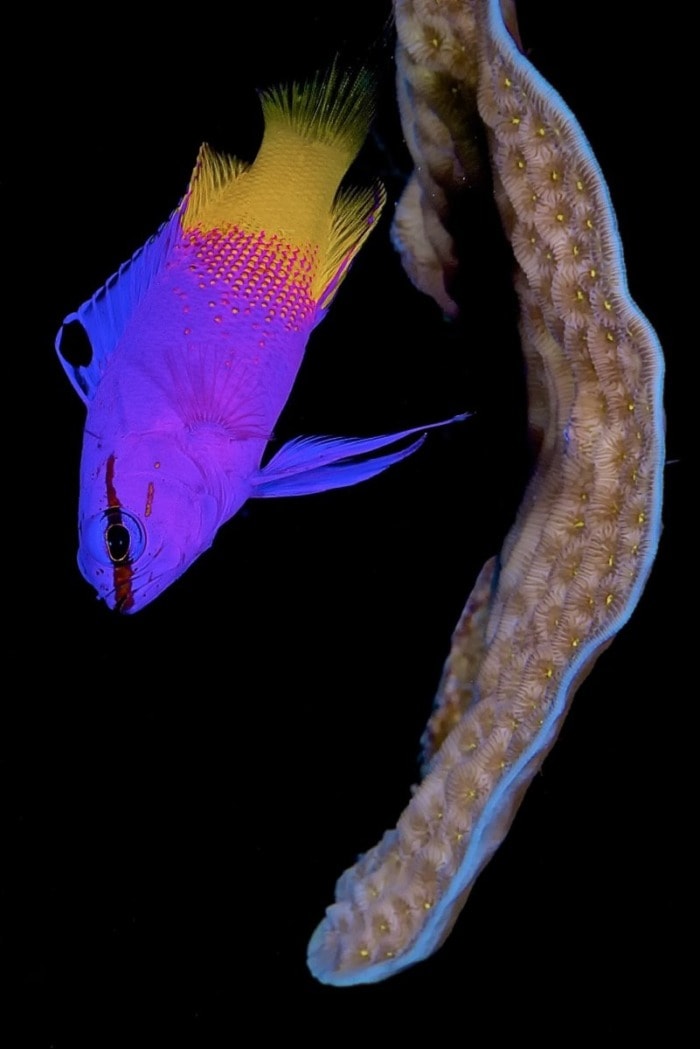
Author’s note: Don’t panic if you see your Royal Gramma swimming around rocks and corals turned sideways or even upside-down. Unlike with freshwater fish where this behavior would signal swim bladder disease, it is normal for this particular species and you should just sit back and enjoy the show.
Anyway, if you’re planning on starting a smaller saltwater aquarium, the Royal Gramma may be perfect for you.
It only grows to around 3.5 inches and can be kept in a 30-gallon tank.
It’s reef compatible too, so if you need a fish that can be kept with corals – you’re good to go.
- Max adult size: 3.5 inches (nearly 9 cm);
- Minimum tank size: 30-gallon (15-gallon is not out of the question);
- Key traits: vibrant colors, not really aggressive, not difficult to look after, will fight among each other, but won’t bully other species; safe in reef tanks; needs rockwork to perch on and hide in; slightly territorial – will choose a spot and claim it as its own.
5. Scott’s Fairy Wrasse – Cirrhilabrus scottorum

The Scott’s Fairy Wrasse is a fascinatingly colorful saltwater fish that will give your marine aquarium an outstanding exotic note. It comes from the Cirrhilabrus genus, which inhabits the reefs in the Indian and Pacific Oceans.
This fish is relaxed and sturdy, so you won’t have an issue taking proper care of it, even if you’re a novice.
Nevertheless, since it’s an active swimmer and it grows a bit bigger than other entries on this list, the Fairy Wrasse needs a larger tank of at least 55 gallons, and, ideally, 90 gallons.
Anyway, since Scott’s Fairy Wrasse is not an aggressive fish, it gets along with other peaceful tank mates, such as the Tailspot Blenny and the Yellow Prawn Goby.
Just avoid keeping more than one male Fairy Wrasse, as two in the same tank will fight among each other.
Author’s note: There is actually more than one type of Fairy Wrasses fish and they differ in coloration and patterns.
All are gorgeous, with vibrant colors and exotic-looking, but more colorful varieties are usually more expensive.
If you want to try another non-challenging wrasse I recommend checking the Carpenter’s Flasher Wrasse.

Anyhow, the Scott’s Fairy Wrasse also makes a great addition to a reef tank, as it doesn’t munch on corals.
If you are to keep these buddies, make sure the tank has a lid, as Fairy Wrasses are big-time jumpers.
I can’t tell you how sad it is to lose such a pretty fish to a random event such as forgetting to close the lid.
Overall, if you aren’t an experienced saltwater aquarist, but you still want to start a beautiful tank with captivating fish in it, Scott’s Fairy Wrasses should be one of your top picks.
- Max adult size: 6 inches (15.2 cm);
- Minimum tank size: 55-gallon aquarium (ideally 90-gallon);
- Key traits: vibrant colors, cool patterns, and exotic looks; active swimmers; a peaceful community fish; hardy; jumpers, so the aquarium has to have a lid; reef tank safe; can be kept with other calm tank mates; avoid keeping 2 Fairy Wrasse males, as they will fight.
6. Banggai Cardinalfish – Pterapogon kauderni

If someone new to saltwater aquariums is looking for a colorful fish with interesting looks I’d recommend them to check out the Banggai Cardinalfish.
Banggai Cadrinalfish are part of the Pterapogon genus, which belongs to the Apogonidae family of saltwater cardinalfishes. This exotic fish species requires low maintenance, which is always welcome, beginner level or not.
The Banggai Cardinalfish typically grows to around 3 inches but sometimes it’s not unheard of to reach 3 inches long when mature.
Because of their size and the fact that they like swimming around you should ideally keep these fish in a 30-gallon tank.
With that being said, if you’re only keeping a single specimen along with another small fish, you can keep them in a 15-gallon aquarium.
Author’s note: It’s important to make sure that the Cardinal you get is captive-bred. By doing so your new saltwater pet fish won’t be as picky when it comes to eating. Wild-caught Banggai Cardinalfish just won’t eat flakes and pellets.
Anyway, for the first couple of weeks after introducing it to its new home, feed your Cardinalfish with live feeder shrimp, frozen brine, mysis shrimp or bloodworms. This way you will make it feel more comfortable.
After it starts feeling safe in its new home, the Banggai Cardinal will start eating flakes and other dry marine foods.
It’s normal for these pet fish to be a bit shy at first but in time they will start showing their true personalities and beauty more often.
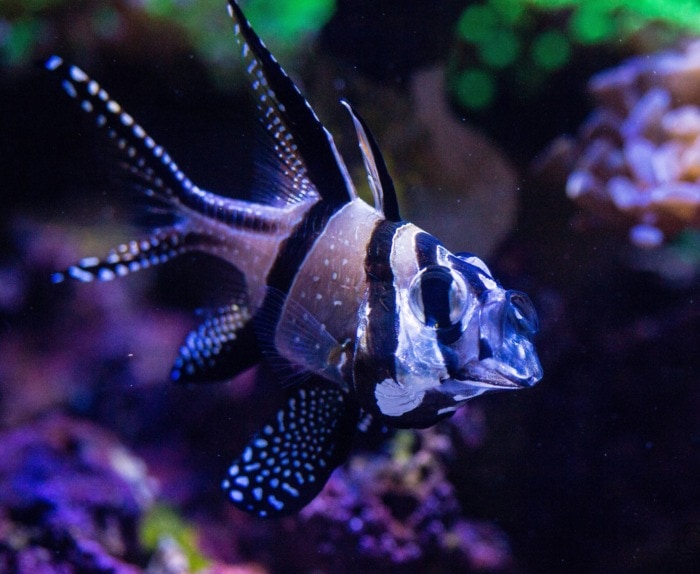
The Banggai Cardinalfish is known to be one of the easiest fish species to breed at home.
Nevertheless, I haven’t had luck when picking a mated pair, as one would bully and eventually kill the other.
Speaking of which, even though Banggai Cardinalfish are peaceful and get along with many tank mates they would often fight and even kill each other. So if you’re not trying to breed them, I’d recommend going for just a single Banggai Cardinal at a time.
Anyhow, with their beautiful black stripes and white-dotted fins, Banggai Cardinals stand out beautifully in a saltwater aquarium.
They also make a great addition to a reef tank, as they don’t nip at corals.
I’d recommend this species to anyone who’s looking for stocking ideas for a 15 to 30-gallon saltwater aquarium.
- Max adult size: up to 3 inches (7.6 cm);
- Minimum tank size: 30-gallon tank (a 15-gallon tank is not out of the question, but only if you’re advanced);
- Key traits: peaceful, hardy, and non-demanding, will fight among each other, but won’t fight other species; is safe around corals.
7. Falco Hawkfish – Cirrhitichthys falco
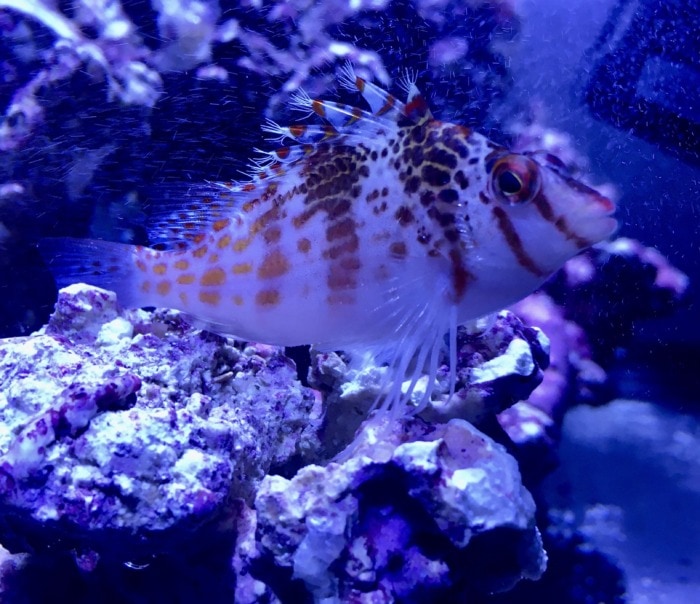
Cirrhitichthys is a genus that is composed of marine ray-finned fish, and specifically, hawkfish belonging to the family Cirrhitidae.
The Falco Hawkfish has an entertaining personality and a pretty exotic appearance. However, most importantly – this species is resilient and is fairly simple to look after, making it a perfect marine fish for beginners who are just starting out.
It reaches 2.5 inches when fully grown, and therefore doesn’t require a large tank to feel comfortable.
The Falco Hawkfish is also a bottom dweller that can live happily in a 30-gallon aquarium with rockwork to perch on.
Mine would routinely climb rocks and monitor what’s happening in the tank.
I find this patrolling behavior extremely amusing.

Anyway, even though the Falco Hawkfish is easy to feed and take care of, it’s somewhat aggressive towards smaller, more timid fish.
This aggression seems to be solidified if the other fish are introduced after the Falco.
However, don’t mistake this behavior for being a bully – it’s just that this fish is predatory.
The Falco Hawkfish won’t ever bother other tank mates that are not considered food.
Therefore, if you want to start a community saltwater aquarium with a Falco Hawkfish in it, it’s best to choose similar-sized or larger tank mates.
The companion fish should also not be too shy and passive.
With that being said, the Falco Hawkfish is a great pet fish for both beginners and advanced hobbyists who are looking for some personality in their tank.
- Max adult size: 2.5 inches or 6.4 centimeters;
- Minimum tank size: 30-gallon aquarium;
- Key traits: unique looks, hardy, semi-aggressive, perches on corals, and is safe for a reef tank but may attack smaller shrimp.
8. Yellow Watchman Goby – Cryptocentrus cinctus

The Cryptocentrus genus includes all fish known as Watchman Gobies, which are part of a larger group known as prawn or shrimp gobies.
The Yellow Watchman Goby is a calm beginner-friendly fish with a bright yellow color that is an excellent eye-catcher in a saltwater aquarium. These fish aren’t aggressive towards their tank mates, but would sometimes get territorial with their own kind.
If you plan to keep a couple, make sure you introduce them at the same time into the system.
Gobies would claim a spot in the tank, considering it their piece of real estate.
For this reason, they will try to guard it against bypassing intruders.
Anyway, the Yellow Watchman Goby needs a sandy bottom, which it would sift through and aerate.
They aren’t the most thorough sifter Goby fish out there, but they will keep the substrate around their spot perfectly aerated. Also, if you like the idea of keeping sand sifting gobies, you should also check the Tiger Watchman Goby and the Sleeper Banded Goby in the article I linked to.
Both species are suitable for beginners and super interesting to observe.
Anyhow, Watchman Gobies usually grow to around 3 inches, but may sometimes reach up to 4 inches upon good care.
They should be kept in a minimum of a 30-gallon tank, which is ideal for novices who aren’t ready to go big with their saltwater aquariums yet.
Author’s Note: The Watchman Goby is also known as Yellow Prawn Goby and can form a symbiotic relationship with shrimp. I’ve had a tiger pistol shrimp that paired with my Yellow Prawn, and their co-op was fascinating to observe.
If you’re looking for one more reason to get a goby – these fish are, generally speaking, resistant to nasty parasites such as the Marine Ich. Treating Marine Ich in a display reef tank is not at all easy, so this is another point for the gobies in my book.
With all being said, if you are new to saltwater tanks, you should consider getting a Watchman Goby as a starter fish.
This species is one of my personal top picks on this list.
- Max adult size: 3 inches (7.6 cm);
- Minimum tank size: 30-gallon aquarium;
- Key traits: bright yellow color, lacks aggression towards other fish and is tough; substrate sifter, great for community tanks and reef tanks; can form a symbiotic relationship with shrimp.
9. Blue-Green Chromis – Chromis Viridis
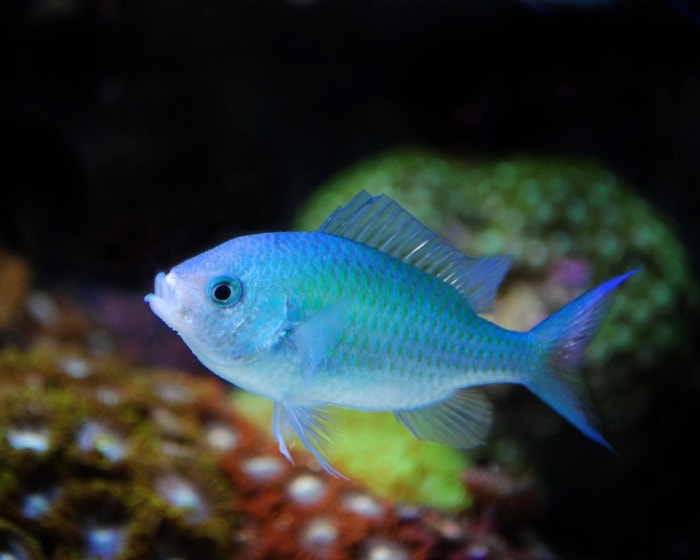
The Chromis genus contains most of what we refer to as Damselfish, but not all of them.
The Blue-Green Chromis are active and reasonably peaceful damselfish that are a good choice for beginners. This is so because they have attractive green-blue coloration and cool personalities that they’re happy to show off while swimming around.
Blue-Green Chromis fish are reef compatible and get along with a vast number of other calm species.
They are aggressive eaters though, so make sure all of your other pet fish in the tank get enough food when feeding.
I recommend adding at least 3 Blue-Green Chromis, as they’re happier when they have a company of their own kind.
I’ve had great success with keeping a school of 3 Blue-greens and a pair of Ocellaris clownfish in a 30-gallon aquarium.
Anyway, if you’re new to the hobby, and you’re looking for a hardy, calm, and yet active saltwater pet fish, think about getting Blue-Green Chromis.
You won’t regret it.
- Max adult size: 4 inches (10.2 cm);
- Minimum tank size: 30-gallon aquarium; 125 gallons for a group of 8 members;
- Key traits: active swimmers, aggressive eaters, yet peaceful; gets along with other timid tankmates; prefers being in groups of at least 3 of their own species; one of the easiest damselfish to keep; is safe for reef aquariums.
10. Red Firefish Goby – Nemateleotris magnifica
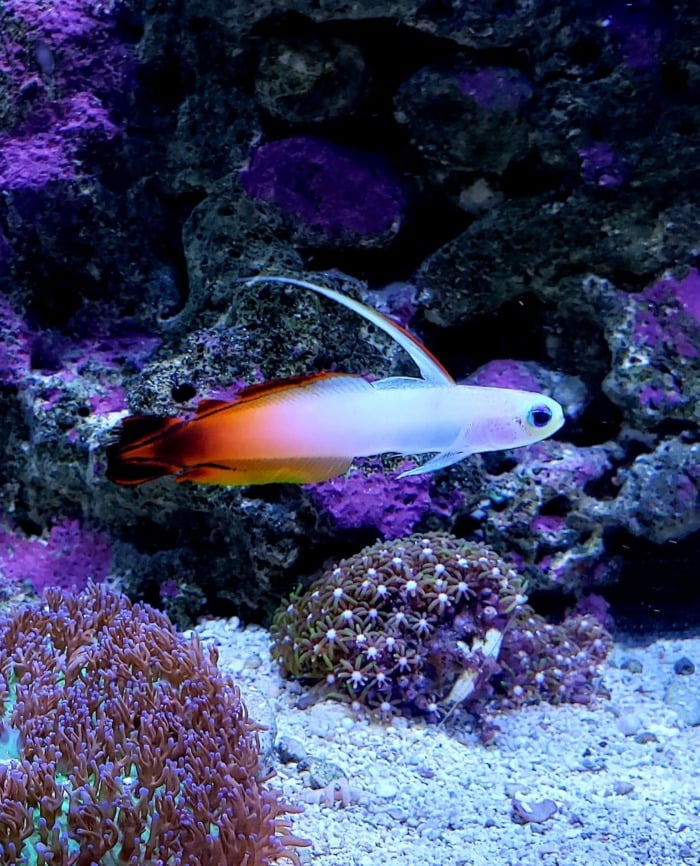
The social and undemanding nature of the Red Firefish Goby (Nemateleotris magnifica) make it one of the best saltwater fish for the beginners in our hobby.
Firefish Gobies rarely exhibit any aggression and typically get along with most tank inhabitants that you’d call peaceful.
The only occasions in which you might see these colorful fish become violent is when they’re kept with others of their kind.
Fortunately, this can be easily prevented if you keep them in a bonded pair (a male and a female).
Anyways, another bright side of Firefish Gobies is their low space requirements.
Due to their unfussy nature and character, they require only 20 gallons of water.
Despite their limited space requirements, however, these fish do need plenty of hiding spots in the tank.
You’d want to make sure your rockwork and corals provide some crevices and other places for retreat for the gobies.
Author’s note: Firefish Gobies are avid jumpers so you’d want to keep them under a lid.
- Max adult size: 3.5 inches (9 cm);
- Minimum tank size: 20 gallons;
- Key traits: Peaceful but bold; uniquely colored; remains small.
11. Atlantic Chalk Bass – Serranus tortugarum
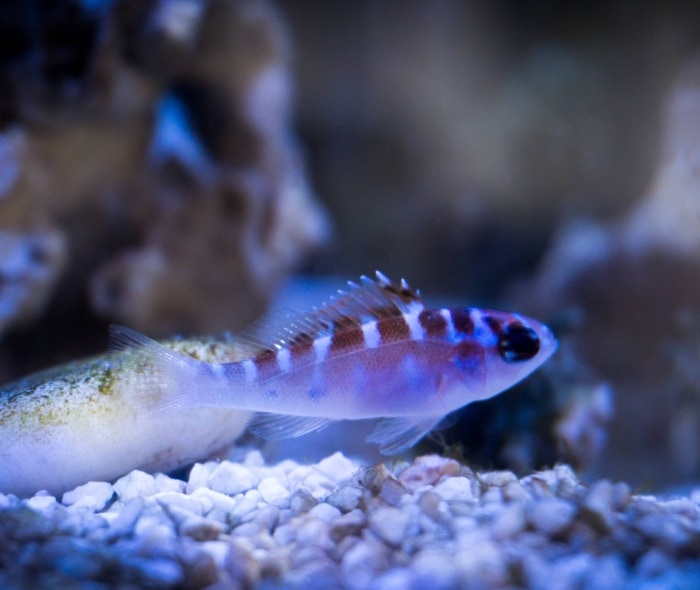
If you’re a fisherman you’re probably getting exciting by the word “bass” right now.
This is not THAT kind of bass.
The Atlantic Chalk Bass from the Serranus genus is a visually appealing saltwater fish that, in my opinion, is great for newcomers to the hobby.
It has an orange body that’s covered in electric blue stripes, giving it a unique appearance.
The Atlantic Chalk Bass doesn’t require plenty of space so a single specimen can be kept in a 30 gallon aquarium.
This fish is also quite sociable and won’t get in the way of other well-mannered fish.
It can, however, go after smaller shrimp so you should keep this in mind.
When Chalk Bass are kept in larger tanks, these fish tend to form loose schools.
They’re also reef safe which is another added benefit if you choose them as one of your starter fish and are into corals.
- Max adult size: 3 inches (7.62 cm);
- Minimum tank size: 30 gallons for a single specimen;
- Key traits: Aggressive feeder; jumper; peaceful and minds its own business.
My Final Words
Starting a saltwater aquarium for the first time can seem somewhat intimidating, even if you’re a longtime freshwater hobbyist.
My reasoning for writing this article was to help ease the anxiety of that, since I still remember how excited it got me back in the days.
Of course, there are other saltwater fish that would also fit a beginner’s aquarium.
Nevertheless, I made sure to include the best species to help you get some cool stocking ideas and make it easier for you.
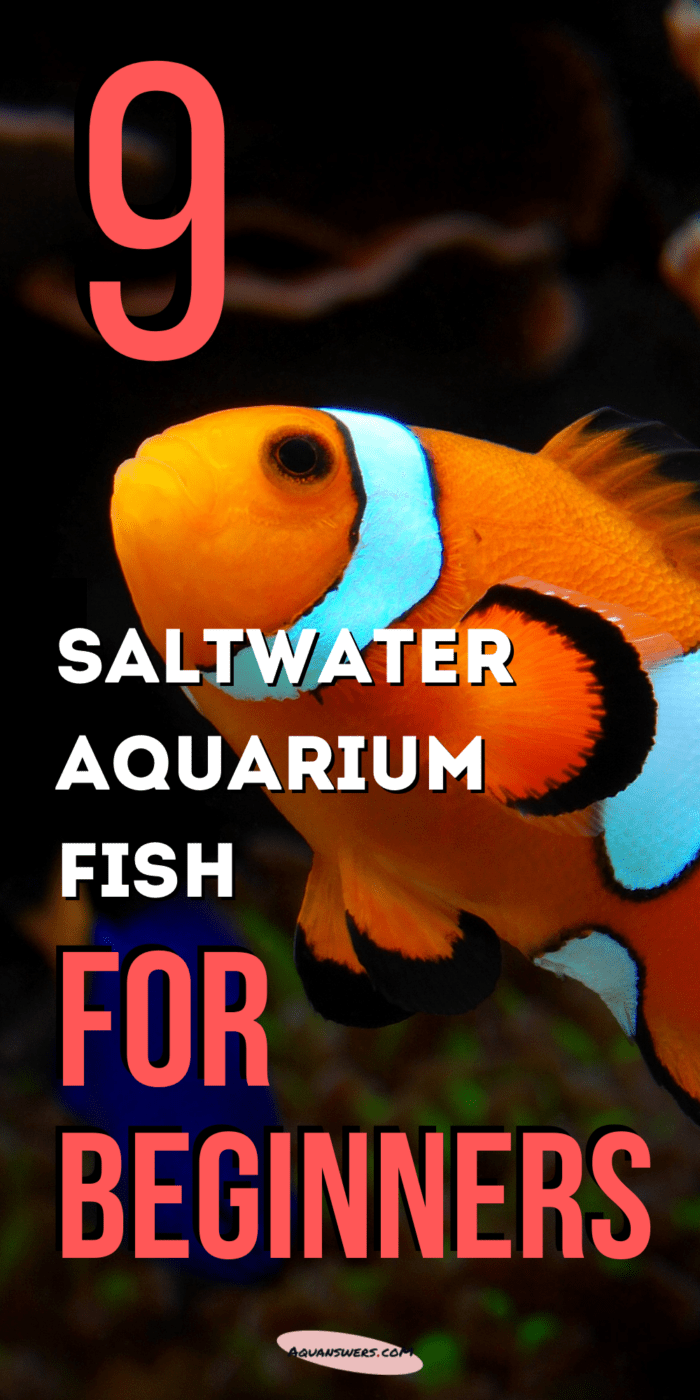
Leave me a comment below to ask me a question or share which pet fish you’ve chosen for your new marine tank.


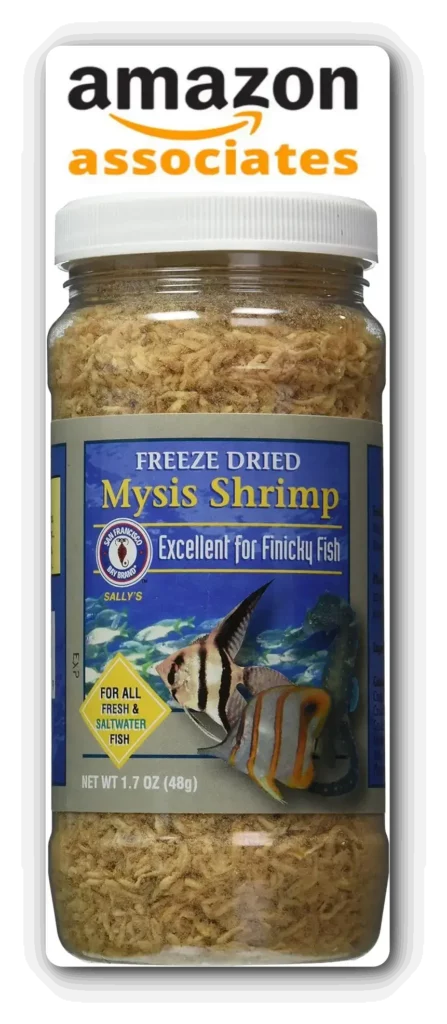




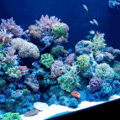

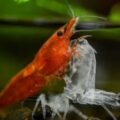
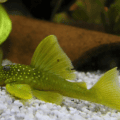


3 thoughts on “The 11 Best Saltwater Aquarium Fish for True Beginners”